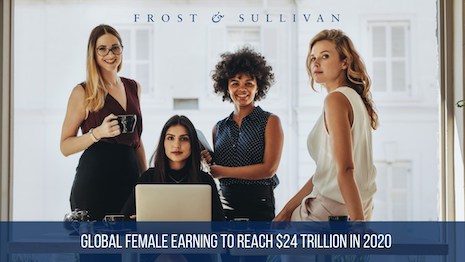 Women are not asking for exclusivity - they want inclusivity. Image courtesy of Frost & Sullivan
Women are not asking for exclusivity - they want inclusivity. Image courtesy of Frost & Sullivan
The female economy is set to outpace the economy of some of the biggest nations in the next five years. New Global Mega Trends to 2030 research from Frost & Sullivan indicates that worldwide female income will grow to $24 trillion this year. As more women enter the workforce, there will be a shift in financial and economic power toward that gender in both the household and professional environments. "The increasing economic power of women will result in a big transformation in product design and marketing,” said Archana Vidyasekar, Santa Clara, CA-based global research director at Frost & Sullivan’s Visionary Innovation Group, in a statement. “Women are expected to spend more than $40 trillion this year, ushering in the need for more focused user-centric strategies and products," she said. "An interesting trend to note is the change in gender strategies, moving from being women-centric to more gender-neutral. In many ways, this is the key to succeed with this segment. “Women are not asking for exclusivity, they are looking for inclusivity – gender-neutral experiences that, unfortunately, are still lacking in many user experiences." Women's day all the way Frost & Sullivan, a consulting and market research firm, identified several insights on the women's economy from its data. First, the global female income is expected to reach $24 trillion annually in 2020, up from $20 trillion in 2018. Second, women are expected this year to control $43 trillion of global consumer spending through voluntary private consumption, or an exchange of money for goods and services. Third, there will be 100 million more women in the global labor force by 2030. Asia Pacific will have the largest female workforce, with millennials representing the largest proportion of female laborers in 2030. Fourth, by 2030, women will change the workforce landscape with a more than 40 percent average participation rate, eventually adding up to 100 million more working women to the global economy. This will bring down the gender gap in labor participation rates by 25 percent in five years’ time. Finally, women-owned companies will this year represent more than 40 percent of registered businesses globally.
